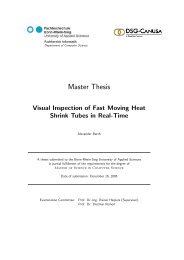Master Thesis - Hochschule Bonn-Rhein-Sieg
Master Thesis - Hochschule Bonn-Rhein-Sieg
Master Thesis - Hochschule Bonn-Rhein-Sieg
Create successful ePaper yourself
Turn your PDF publications into a flip-book with our unique Google optimized e-Paper software.
6. Evaluating the safety <strong>Master</strong> <strong>Thesis</strong> Björn Ostermann page 101 of 126<br />
Since the realization in praxis of the presented concept will still need some time, the old machinery<br />
directive 98/37/EC can be disregarded in the considerations of this thesis.<br />
6.1.1 Machinery Directive 2006/42/EC<br />
Robots, as all machinery, are included in the scope of the Machinery Directive (2006/42/EC). The<br />
requirements on the placing on the market of machinery are laid down in article 5. The safety<br />
requirements are formulated in article 5 a.<br />
“Article 5<br />
Placing on the market and putting into service<br />
1. Before placing machinery on the market and/or putting it into service, the manufacturer or<br />
his authorised representative shall:<br />
(a) ensure that it satisfies the relevant essential health and safety requirements set out in<br />
Annex I;” [66]<br />
The article 5 a refers to annex I, where the relevant essential health and safety requirements are<br />
formulated in detail.<br />
The main requirements, important for the new hazards induced by the presented solution in this thesis<br />
are:<br />
- 1.1.2. Principles of safety integration<br />
- 1.2.1. Safety and reliability of control systems<br />
- 1.2.2. Control devices<br />
- 1.2.3. Starting<br />
- 1.3.7. Risks related to moving parts<br />
The most important aspects of those requirements are as follows:<br />
� 1.1.2. Principles of safety integration<br />
(a) Machinery must be designed and constructed so that it is fitted for its function, and can be<br />
operated, adjusted and maintained without putting persons at risk when these operations are<br />
carried out under the conditions foreseen but also taking into account any reasonably<br />
foreseeable misuse thereof. […]<br />
(b) In selecting the most appropriate methods, the manufacturer or his authorised<br />
representative must apply the following principles, in the order given:<br />
— eliminate or reduce risks as far as possible (inherently safe machinery design and<br />
construction),<br />
— take the necessary protective measures in relation to risks that cannot be eliminated,<br />
— inform users of the residual risks […]<br />
� 1.2.1. Safety and reliability of control systems<br />
Control systems must be designed and constructed in such a way as to prevent hazardous<br />
situations from arising. […]<br />
— a fault in the hardware or the software of the control system does not lead to hazardous<br />
situations,<br />
— errors in the control system logic do not lead to hazardous situations […]<br />
� 1.2.2. Control devices<br />
[…]














